“What’s disgusting? Unionbusting! What’s outrageous? Poverty wages!”---a chant often heard at Fight for $15 actions
Sometimes heroes come dressed in company uniforms: perhaps MacDonald’s, or maybe Subway, Wendy’s, Mrs. Fields or those Whole Foods distinctive black aprons. That kind of hero was out in the streets of Chicago on July 31 and August 1. They had walked off their jobs to support the Fight For $15 campaign led by the Workers Organizing Committee of Chicago (WOCC).
WOCC is a new union in town. Currently with several hundred members and growing, it wants a $15 an hour wage for food and retail workers in Chicago. There are similar groups in other large American cities.
I had the privilege of picketing with WOCC at a Northside Chicago Whole Foods on July 31. I was with also WOCC on August 1 from early morning to early evening as WOCC strikers marched through the Chicago downtown, picketing a number of low wage workplaces and sharing their stories.

“We want change! And we ain’t talking about pennies!”
WOCC members typically make minimum wage or only slightly above. Minimum wage is a poverty wage and despite the common stereotype that minimum wage jobs are for teenage pocket money, the majority of minimum wage workers are adults. Nearly a third of minimum wage workers are supporting families on pay that is below the official poverty line.
Some people might question why walking off the job for a 1 or 2 day strike is such an act of heroism. But a Wendy’s worker put it this way, “I work at Wendy’s everyday. I mean everyday! I get $8.25 an hour. I have 3 kids and can’t provide the basics for my family.”

This Wendy’s worker is already living in poverty and his family is struggling to survive. The loss of his job because of company retaliation could be catastrophic. Jobs are tough to find in this economy. He and other WOCC workers are taking huge risks to fight for a better future. Striking even for a day or two is a courageous act when the striking workers are a still a minority of the retail and food workers in the city.
“Hey workers, tell your story. Tell the whole wide world this is union territory!”
John Jackson works at both Walgreens and Chic-Fil-A. His workday begins at 5:30 am and ends at 9 pm. Walgreens pays him $10.22 and hour and Chick-Fil-A $8.75.
“The reason why I am striking today is that I have to work two jobs to take care of my family. I have a 5 year old son and a 4 year old daughter. And when I get home, I’d like to see them. I don’t see my kids until Friday night. Society says they want a father in the household. All I want is to be able to work a one shift job and take care of my family and be a great father.”
It is not only low wages that are a problem. Low wage workers normally receive few or no benefits.They are also are subjected to a demeaning lack of respect.
Matthew Camp, a Whole Foods cashier, described how Whole Foods uses a point system to diminish the personal lives of its employees:
“We started organizing here at this Whole Foods location against the point system. It’s an unfair attendance policy because we don’t have sick days. If there is any reason why we miss a day of work, it goes on our work record as a demerit. So if we are sick and we decide we don’t want to handle peoples’ food today because we don’t want to get them sick or get our co-workers sick, we get a point. If we get hurt on the job, we get a point. If a friend or family member gets sick--or dies, and we go to take care of them or go to the funeral, we get a point.
What kind of life is that for us to live?"

At Jason’s Deli on Dearborn Street near City Hall, WOCC protested the firing of Shakita Moore, who had objected to racial and gender harassment from managers and co-workers. Moore, an African American, said that she had been subjected to inappropriate touching and repeatedly,”…. threatened with 'a punch in the face'". The managers and co-workers involved were never disciplined.
Other female WOCC members have also reported similar kinds of harassment at other businesses.
A striker named Alexis called her downtown Mrs. Field’s store, ”...one of the most corrupt businesses I have ever worked for.” She explained that checks are often wrong or not paid on time. In addition, the store was without air conditioning for three weeks even though the workers labor in front of hot ovens every 8 hour shift.
“When the working class is under attack. What do we do? Stand up fight back.”
Fight for $15 was able to shut down a Wendy’s, a Subway and a Mrs. Fields during the August 1st action, but many of the businesses where they picketed stayed open, even after some workers had walked out.

WOCC members hope their acts of courage will help cut through the terrible fear that grips many low wage workers and keeps them from resisting the injustices being done to them. Many workers fear that as bad as things are, they could always get worse because of company retaliation. Courage is not evenly distributed among the human species. It usually takes a bold few to awaken it among the majority.

But is this fear justified?
According to Tammy Binford who writes frequently on employment law, the Fight for $15 strikes may be protected actions under the National Labor Relations Act. She and other labor law experts have urged companies to be cautious about retaliation. One Missouri legal firm issued a statement saying:
“Even though failing to report for work or even walking out during the middle of a shift impacts an employer’s operations and may in fact violate an attendance policy, depending on the circumstances, an employer may actually be prohibited from disciplining [employees] or questioning them about such protected activities.”
However the reality is that companies already get away with illegally firing workers for union activities. One recent study estimated that about one third of union organizing campaigns result in illegal firings. These can take months or even years to go through the legal system. When companies are fined for illegal activities, they just accept that as the cost of doing business.
A manager can always find a reason to fire someone. Everyone makes mistakes and a mistake that would ordinarily be overlooked, can mean termination for a pro-union worker. It doesn’t even have to be a mistake. Managers can sabotage something and blame it on a pro-union worker. Managers can promise favorable treatment to another employee to make up lies. The possibilities are endless.
Our legal system depends upon how much you can afford to pay for “justice”. Powerful corporations have deep pockets. Low wage workers have empty pockets. No wonder 79% of American workers think they would be subject to termination for joining a union campaign. The fear is out there and yeah, it is very real.
As of this writing 60 Walmart workers have been fired for going on strike in actions sponsored by Our Walmart, an employee group fighting the retail giant for a better life.
“When workers rights are under attack, what do we do? Stand up fight back!”
While WOCC members do hope for some protection through the legal system, they know they can’t count it. So WOCC workers are building a culture of solidarity, where working people look out for one another, care for each other and stand up for one another. One of the chants often heard on the picketline was directed to non-striking workers,” You’re not alone! We’ve got your back!”
I saw an example of this at the Walgreens at the corner of State and Washington in the Loop when Walgreens workers already on strike persuaded all but 1 of the remaining employees to join them. I watched as tearful, but joyful workers walked out the front door to join their striking co-workers and receive a heartfelt welcome from WOCC members. It was one of those small moments of love and solidarity that are part of any movement building.

A culture of solidarity is not easy to build in our dog-eat-dog-cat-eat-mouse economy when competition for even the lousiest jobs can be fierce. Turnover is high in the low wage world and it’s often hard to get to know co-workers very well. There are barriers of race, gender, immigration status, language, religion, age and all of the other things that divide us. Then there are the everyday personal hurts and betrayals that can make us cautious around other people.

Solidarity requires a level of trust that some people find almost frightening. But once it happens, it is a transformative experience. Solidarity does not imply uniformity. Naturally there will be disagreement and conflict as workers figure out how best to resist. But if there is an atmosphere of mutual respect, these normal disagreements can be resolved in ways that make solidarity even stronger.
This kind of solidarity can build a movement that in the face of terrible repression can not only survive, but prevail. During the civil rights movement days they called it “building the beloved community”:
“It is a positive force confronting the forces of injustice, and utilizes the righteous indignation and the spiritual, emotional and intellectual capabilities of people as the vital force for change and reconciliation.” ----The Martin Luther King, Jr. Center for Nonviolent Social Change
“Get up. Get down. Chicago is a union town!”
When they can, WOCC will shut down a workplace to draw attention to injustices. This is the classic labor tactic to force management to negotiate. But even when they cannot shut a store down, WOCC members draw attention to how these companies create poverty through their employment policies. They want to inspire workers to join strikes, but they also want to reach the general public.

In a big city like Chicago customers have often choices. There is evidence that Walmart’s terrible reputation has cost it customers who can shop at companies like Costco who have more humane employee relations. If companies retaliate against striking workers, it can rebound against them as customers protest on social media, write angry letters to newspapers or choose other places to spend their money.
WOCC members hope the power of expanded solidarity will win them major gains. After a WOCC action on April 24, a number of WOCC members did see small improvements in their workplaces. No one in WOCC has any illusions that gaining the $15 an hour wage will be quick or easy.
“No burgers! No fries! We want our wages supersized!”
Robert Wilson Jr, a worker at the Navy Pier MacDonalds told of not getting a promotion for seven years and then receiving a manager’s blue shirt and an additional 25 cents an hour after becoming involved with WOCC:
“Yeah, we need a lot more. This organization [WOCC] backed me up and gave me the courage to do what I have to do to get what I deserve. This business has skyrocketing profits but all we get is chump change.”
Crystal, a striking worker at Nordstrom's told of her experience with WOCC:
“I’m here to stand with my co-workers and because I know striking works. Before the last strike when Nordstroms found out about it they gave us a quarter raise to try and keep us from going on strike. So I said thank you for the quarter but I’m still going on strike. Yesterday I was offered a promotion that will come with, I think, a $1.25 an hour raise. Again I said thank you and I went on strike.”
A solidarity culture can still have a positive effect within a workplace even if it has not yet won significant material gains. Workers who have hope for the future feel better about themselves and others around them. This can reduce workplace stress and make hard alienating work less unpleasant. And management, please take note: For those who work directly with the public, it can result in a better customer experience.
“What’s outrageous? Poverty wages!”
WOCC members are often asked how receiving $15 an hour wage would change their lives. Some common themes come up. Here are a few. People talk about wanting to adequately provide for their families and spend more time with their children. People want to go to school to achieve career and personal goals. They are concerned about health issues and having access to medical care. They want more rest and relaxation and be able go out to a movie or a club, or even take an extended vacation.
Yet huge companies making mega-profits treat these modest aspirations as if they were dangerously subversive ideas, a threat to the very existence of American capitalism. Through their own lobbying teams and through trade groups like the National Restaurant Association, the Chamber of Commerce and the American Legislative Exchange Council, they spend millions to enforce poverty upon American workers.
They take aim at minimum wage standards, health and safety regulations, wage-hour laws, discrimination laws, the right to join a union and so much more. What they cannot achieve by legislation, they achieve by attacking the government agencies charged with enforcing labor laws or by financing deep pockets lawsuits in the court system.
“I’ve been at Macy’s for 3 years and I just received a 25 cent raise as a result of the April 24th strike and that’s a small victory...but that is not what we are fighting for. We are fighting for $15 an hour. The people who run these companies aren’t struggling to raise their children and live their lives, but we’re the ones making all of this money for them. So we shouldn’t have to struggle either.”----a Macy’s worker
Poverty is a policy. With the power of wealth large companies help shape US economic policy and the result one of the worst poverty rates among comparable nations. In Chicago, the neighborhoods with the most deadly violence are the poorest in the city. In Chicago one third of the children live in poverty when family income is the best single predictor of student success. Thanks to the ravages of poverty with its physical and mental stresses, there are Chicago neighborhoods where the health of the residents is worse than in some countries in the Global South. The list goes on…
Now imagine a Chicago transformed by a drastic reduction in poverty, a Chicago that has fought for $15 and won.

“Strike! Strike! Strike! Organizing is a right!”
When the heroes in company uniforms strike for $15 they are striking on behalf of low wage workers across the city. They are striking for an economic recovery that starts from the bottom up instead of being stalled at the top with bank bailouts and obscene CEO bonuses. Along with other low wage workers across the nation, WOCC is on the frontlines of a non-violent war on poverty. They need the solidarity of the rest of the working class who will also benefit from rising wage levels. The rest of the working class can also learn from the militancy of the WOCC example.
“It’s not just us out here fighting, there are people across the country going through the same struggles, maybe even worse struggles, than us.We’re making history right now, we’re showing that minimum wage isn’t enough, this poverty wage isn’t enough." ----Andrew Little, stockroom worker at Victoria's Secret.In the classic French film The Wages of Fear, four desperate men drive a truckload of explosives over a dangerous mountain road, risking their lives for a paycheck. Our wages of fear are the poverty level paychecks that are enforced through intimidation and reprisals. But the dysfunctional economy they have created with vast wealth at the top, grinding poverty at the bottom and a shocking economic inequality can also be socially explosive.
Societies that allow such vast inequalities have historically experienced social upheavals that include civil disorder and even revolution. Today’s mega-corporations would be wise to calculate that possibility into their future financial projections.

Sources consulted
"We Are Slowly Dying": Fast Food Workers Launch Strike for Living Wage and Right to Unionize Democracy Now!
Fast-food worker strikes continue to spread in major U.S. Cities by Tammy Binford
Stop the Bullying, Wal-Mart Bloomberg Businessweek
Fast Food Strikes Catch Fire by David Moberg
Standing up for Shakita by Trish Kahle
Dropping the Ax: Illegal Firings During Union Election Campaigns, 1951-2007 by John Schmitt and Ben Zipperer
Worker wages: Wendy's vs. Wal-Mart vs. Costco by Emily Jane Fox
The King Philosophy bv the King Center
A WGN radio interview with Whole Foods striker Trish Kahle
Can McDonalds Make A Profit While Paying $15 An Hour? by Bryce Covert
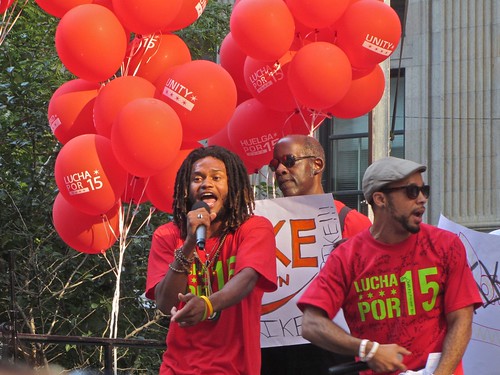
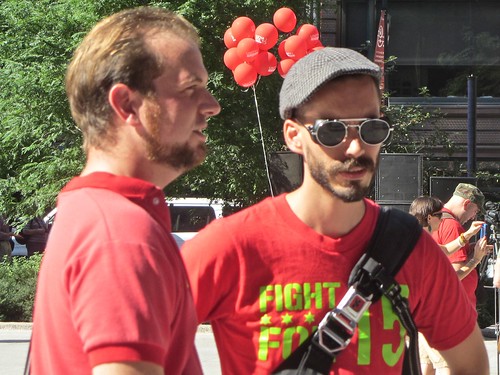


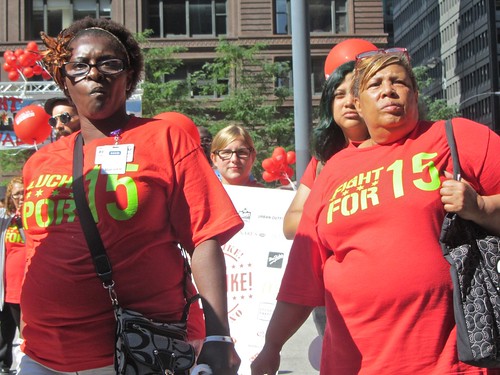
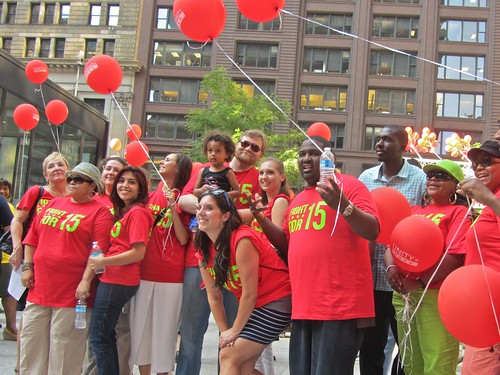


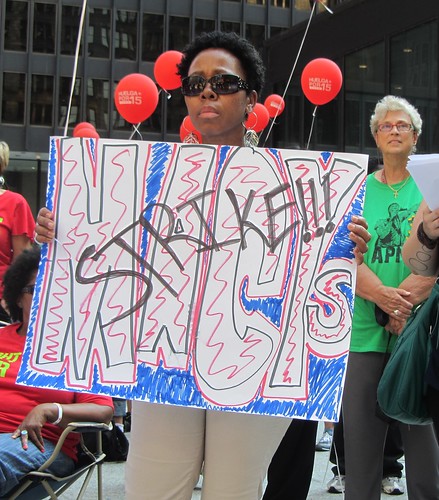
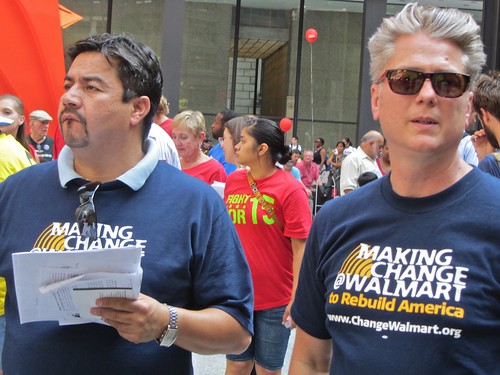

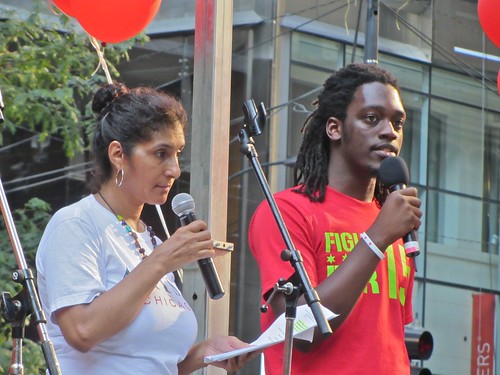
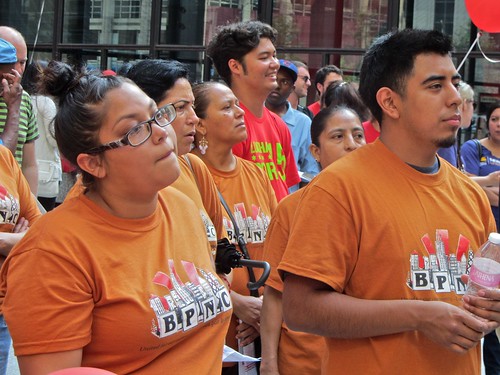
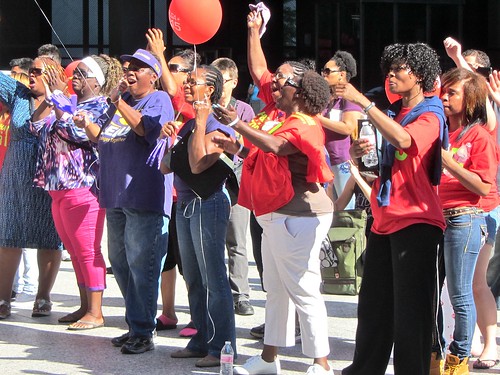


























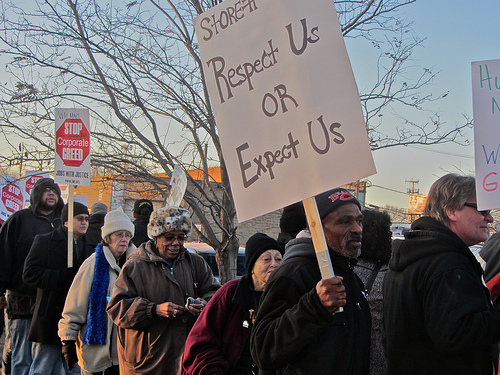


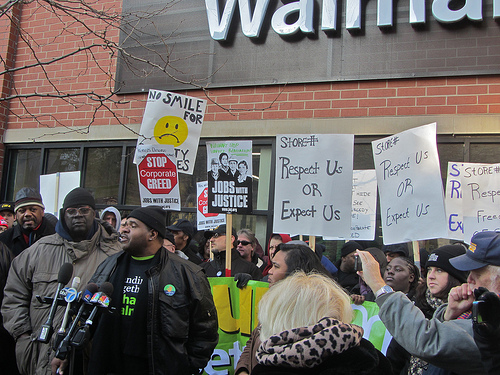
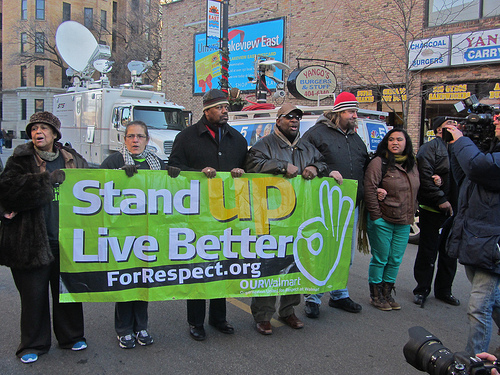
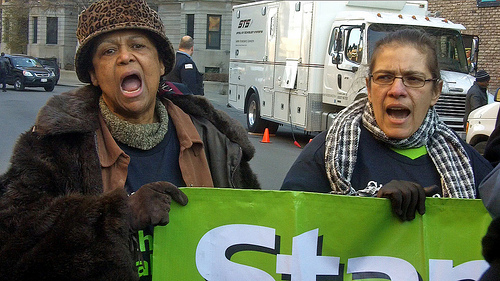











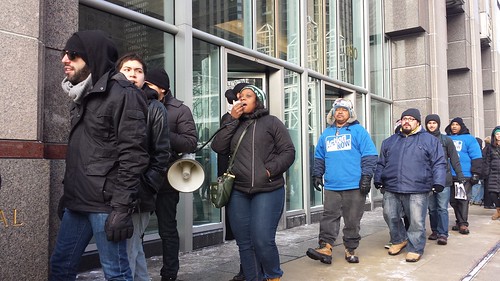
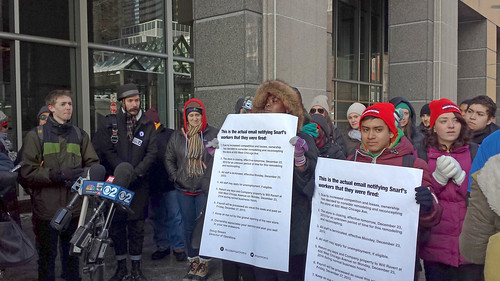
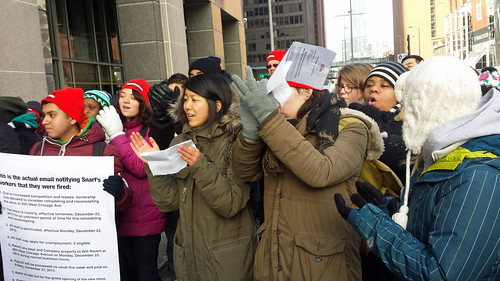
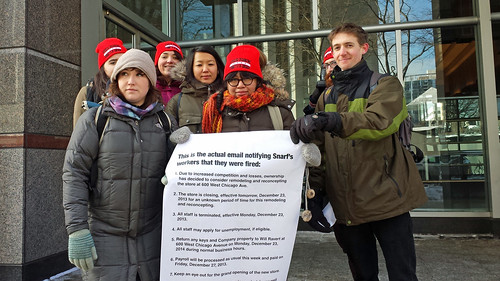
























































 Zerlina Smith speaks out for racial and economic justice to commemorate the 60th anniversary of the Brown decison
Zerlina Smith speaks out for racial and economic justice to commemorate the 60th anniversary of the Brown decison
 West Siders and allies gather in the LaFollette Park
West Siders and allies gather in the LaFollette Park 













